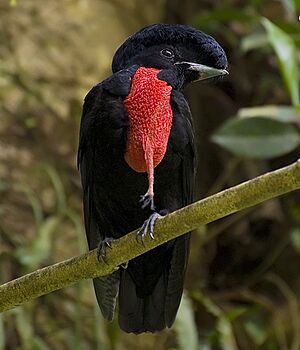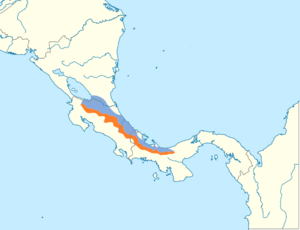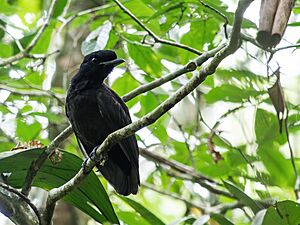Bare-necked umbrellabird facts for kids
The bare-necked umbrellabird (Cephalopterus glabricollis) is a special type of bird that belongs to the Cotingidae family. You can find these birds in the forests of Costa Rica and Panama. They love living in forests and mostly eat fruits.
These birds are considered endangered because their homes (forests) are disappearing.
Quick facts for kids Bare-necked umbrellabird |
|
|---|---|
 |
|
| Male | |
| Conservation status | |
| Scientific classification | |
| Genus: |
Cephalopterus
|
| Species: |
glabricollis
|
 |
|
Contents
What's in a Name?

The bare-necked umbrellabird is one of three kinds of birds called umbrellabirds. They are all part of the Cephalopterus group. A scientist named John Gould first described this bird in 1851.
The name Cephalopterus comes from ancient Greek words. "Kephalē" means head, and "pteros" means feathered. This refers to the cool feathers on the heads of some umbrellabirds. The second part of its name, glabricollis, comes from Latin. "Glaber" means bald, and "collis" means necked. This describes its bare neck!
What Do They Look Like?
The bare-necked umbrellabird is a big, strong bird. It looks a bit like a crow. It's the largest passerine (a type of perching bird) in the areas where it lives. It's also one of the biggest cotinga birds. Only the Amazonian umbrellabird is larger.
Male umbrellabirds are bigger than females. Males can be about 41 centimeters (16 inches) long and weigh around 450 grams (16 ounces). Females are a bit smaller, at about 36 centimeters (14 inches) long and weighing 320 grams (11 ounces).
Where Do They Live?
You can find the bare-necked umbrellabird in Panama, Costa Rica, and the southern part of Nicaragua. They prefer to live deep inside old, untouched forests. Sometimes, you might see them looking for food in younger forests too. They like places with thick plants and lots of fruit trees.
These birds move up and down mountains during the year. This is called altitudinal migration. They do this to find the best fruits. For most of the year, males stay in lower areas, between 100 and 500 meters (330-1,640 feet) high. Females are usually around 200 meters (660 feet) high. But during their breeding season, from March to June, they move higher up. They go to elevations of 1,000 to 1,500 meters (3,300-4,900 feet). This is when there are lots of fruits available in those higher areas.
How Do They Live?
What Do They Eat?
Bare-necked umbrellabirds mainly eat fruits. They enjoy berries from different plants like Marcgraviaceae, Urticaceae, Arecaceae, Lauraceae, and Annonaceae. But they don't just eat fruit! They also sometimes eat lizards, frogs, insects, and insect larvae.
They get their food by plucking fruits from plants while flying. They can also hop heavily to grab food. One young bird was even seen eating arthropods that were scared out by a group of army ants in Costa Rica.
How Do They Breed?
Bare-necked umbrellabirds breed between March and June in Costa Rica. In Panama, they breed from April to September. Like other cotinga birds, the male umbrellabirds perform special dances and calls to attract females. These performances happen in areas called "leks."
What Is Their Status?
The bare-necked umbrellabird is listed as endangered on the IUCN Red List. This means they are at a very high risk of disappearing forever. Scientists believe there are fewer than 2,500 adult birds left in the wild, and their numbers are still going down.


